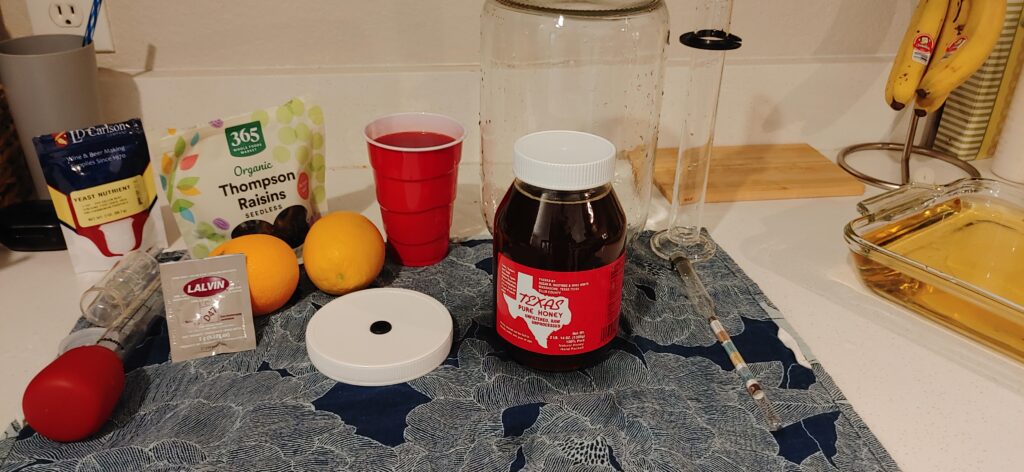
Blood Orange Mead
As soon as I decided I was going to start brewing Meads, I wanted to brew something with blood oranges. I used at total of eight blood oranges for juice and zested two of the eight. The honey is from Waxahachie, TX which is just down the road from me a little bit.
Section Index
Ingredients
- Texas Pure Honey (Waxahachie, TX) (46oz)
- Fresh Blood Oranges (20oz juice, zest of 2)
- 1 stick of cinnamon
- 1 packet Lalvin D47 yeast
- Small handful of raisins, finely chopped
- Tea of 1 black tea bag in 4oz of water
Preparation
To get started, I sanitized a 1 gallon wide mouth jug, turkey baster, graduated cylinder, (new) hydrometer, lid, and 3-piece airlock assembly. After rinsing the jug with water and allowing to drip some, I added the honey. I filled the mostly empty honey jar with warm, filtered water and shook vigorously to melt and dissolve the remaining honey, then added it into the jug. I washed 2 blood oranges in warm-to-hot water to cleanse the skin, then zested those two oranges. After that, I halved a total of 8 oranges (including the 2 zested oranges) and juiced them with a manual juicer. It produced 20oz of beautiful red juice which tasted tart, but sweet. Very much a combination of sweet orange (like mandarin) and tart grapefruit juice. I poured the juice into the jug and added the zest. At this point, I also added the yeast nutrient (1 tsp) to the jug as well.
Next, I chopped a small handful of raisins to provide some tannin. As the suggestion of Brian and Derica from City Steading Brews, I brewed 1 tea bag in about 4oz of hot water. Once the tea was done, I discarded the tea bag and poured the water (now tea) into the jug. I added about 40oz of cold, filtered water to the jug and then put the lid on. I covered the airlock hole with a finger and shook the contents vigorously to combine. After about 2 minutes of shaking, I set the jug back down and removed the lid. I realized I nearly forgot the cinnamon stick so I tossed one in to the jug, added enough water to fill the jug the rest of the way, and shook another 2 minutes to combine and thoroughly oxygenate the brew.
After thoroughly mixing, I drew out enough Must with the turkey baster to float my hydrometer inside the graduated cylinder. The initial Specific Gravity (SG) reading for the must was 1.110 which implies a theoretical maximum ABV of 14-15%. Since the testing equipment was sanitized, I added the test quantity back into the jug. I used Lalvin D47 yeast for this brew and pitched the whole packet into the jug. I used the turkey baster to break the surface tension of the Must to allow the yeast to sink since there was a lot of orange zest floating at the top.
Finally, I placed the lid with the airlock back on the jug and screwed on the lid tightly. The Must was then moved to it’s new home in the Magic Room of Fermentation.
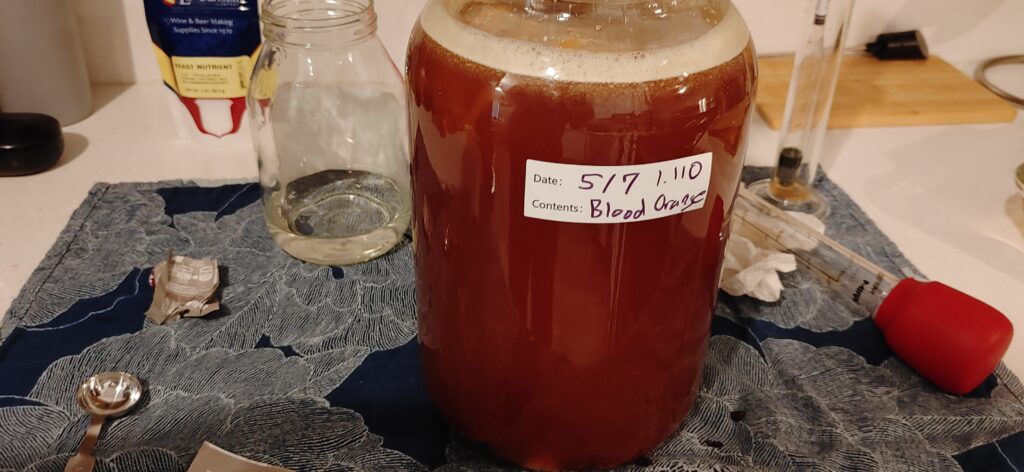
First rack
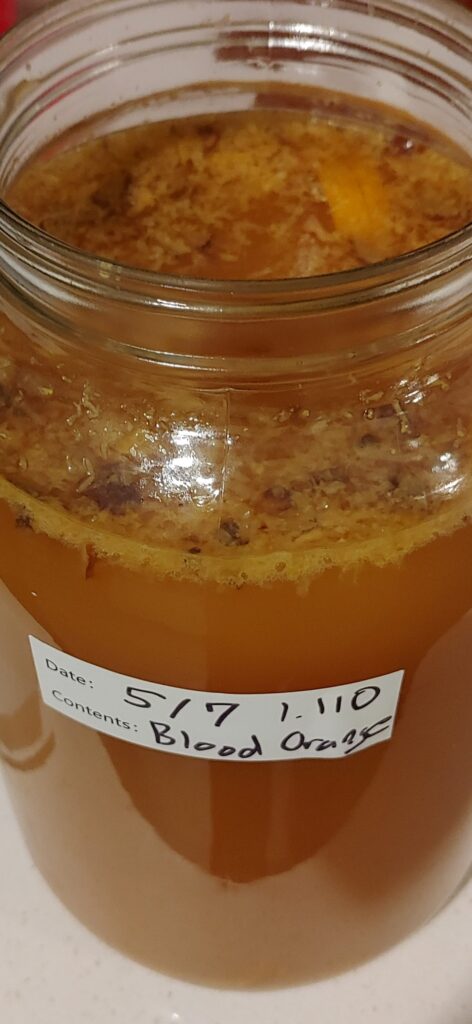
After an unbelievably active 5 days, the mead had fermented to dryness (1.000 SG). Having solids floating on the top (zest, pulp, and raisins) was a concern for me as they can be a starting point for mold infiltration and I decided to rack off the mead. I wracked into a 1 gallon carboy, added an airlock and bung, then placed in the fridge to allow it to cold crash out. There was a lot of lees and other sediment already at the bottom and I didn’t want any of the pulp or zest to make it into the new fermenter. So there was some loss during this rack. The fluid level in the carboy was below the shoulder so there was a lot of exposed surface area and I decided it’d be safest to cold crash it, pasteurize it, and the bottle it quickly.
Second rack & Pasteurization
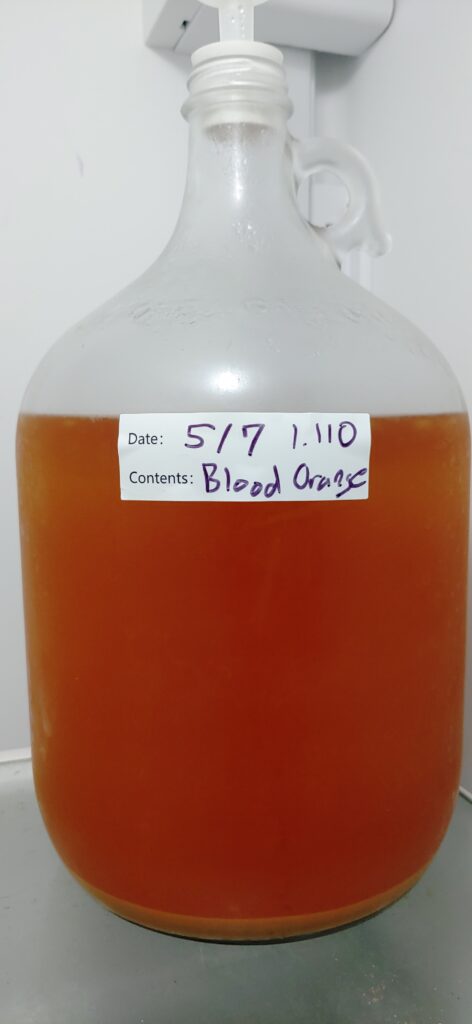
After cold crashing, I had about another 3/4″ of sediment built up in the bottom of the carboy. I racked the mead off into a clean wide mouth 1 gallon container then placed that in a large pot with a jarring rack underneath the container. The jarring rack is super important because if your fermenter or container rests directly on the bottom of the pot, you’ll likely break the glass as you heat the liquid. I filled the pot with enough water to make it full and turned the stove on medium low heat. I used a bit of foil to cover the container, just to prevent as much steam from forming. Once the water was 150F, I moved the thermometer into the mead. Once the mead had reached 140F (the temperature at which yeast dies), I put the stove on Low and allowed it to stay at 140F for 15 minutes. After that, I turned off the stove and let the mead start to cool.
Once the mead was at around 125F, I removed the container from the pot and set it on a towel on the counter to accelerate cooling. When the mead got to 100F, it was time to backsweeten.
Backsweetening
This mead was saucy and spunky and tasted very young but VERY good. The orange and citrus really made a strange nearly hydrocarbon taste upfront and mellowed out across the back. The after taste was extremely nice. To make the front a bit easier on the pallet, I added 1/2 cup white sugar and stirred thoroughly, but gently to avoid making bubbles. A second taste was right about on the money for me. It was DELICIOUS. I took a final density reading and found it was 1.010 SG.
Again, because there was so much loss, I decided it was the safest to avoid making vinegar was to go ahead and bottle the mead. Yes, there will be sediment in the bottles, but that’s why there is a shoulder on wine bottles and you shouldn’t ever just upend a wine bottle. Instead, pour slowly and in a controlled manner.
Bottling
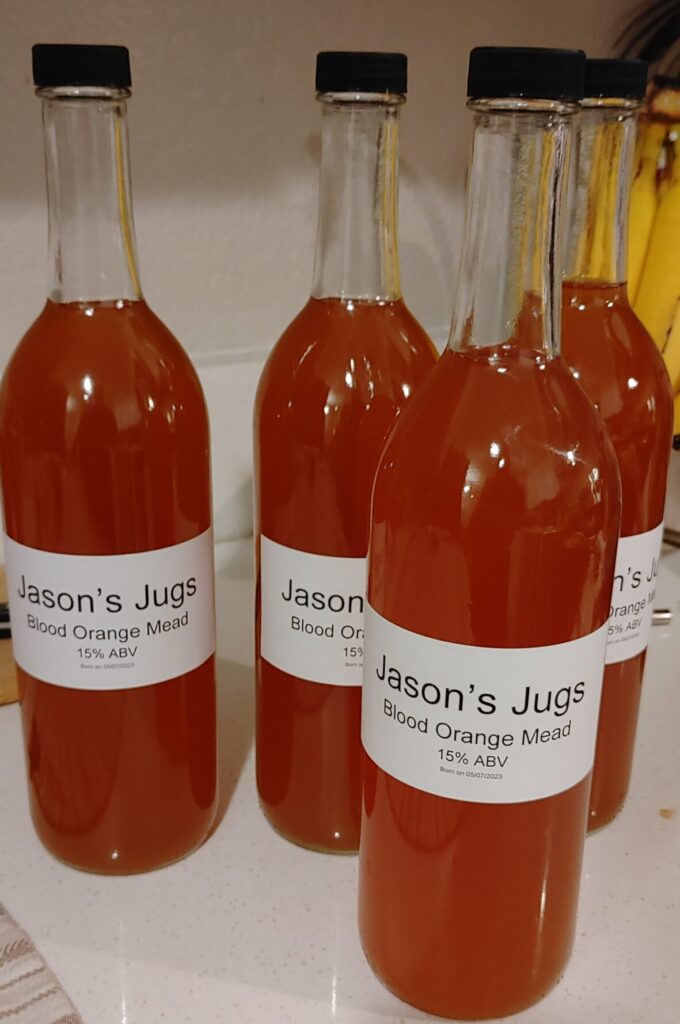
Using a freshly sanitized auto-siphon, hose, and bottling stem, I bottled the mead from the pasteurizing container once it was around 90F. I recommend having a hose clamp in addition to the bottling stem since the stem tends to dribble continuously under the siphon pressure.
Every drop of mead is precious!
The final volume of mead was 3289mL which gave me 4 full 750mL bottles and a pleasant drink at the end.
Conclusion
This mead is still young, but I don’t expect this one will be allowed to age for very long. It will be my donation to my ND5DX’s 2023 Field Day event and my amateur radio brothers. That’s the beautiful thing about mead, I think. Yes, it gets better as it ages. But also yes, it can be, and sometimes suggested, to drink immediately. It is truly the drink of the gods!
Final thoughts: (pending a heavy drink on June 24th. Check back then!)